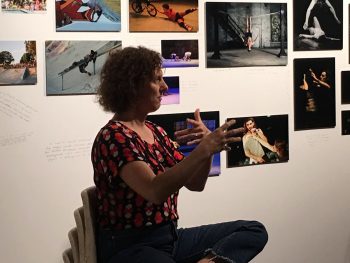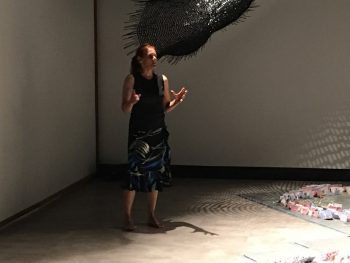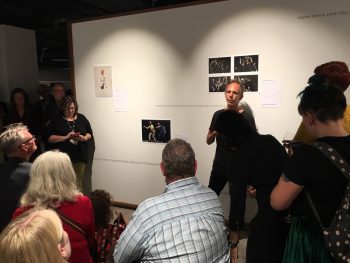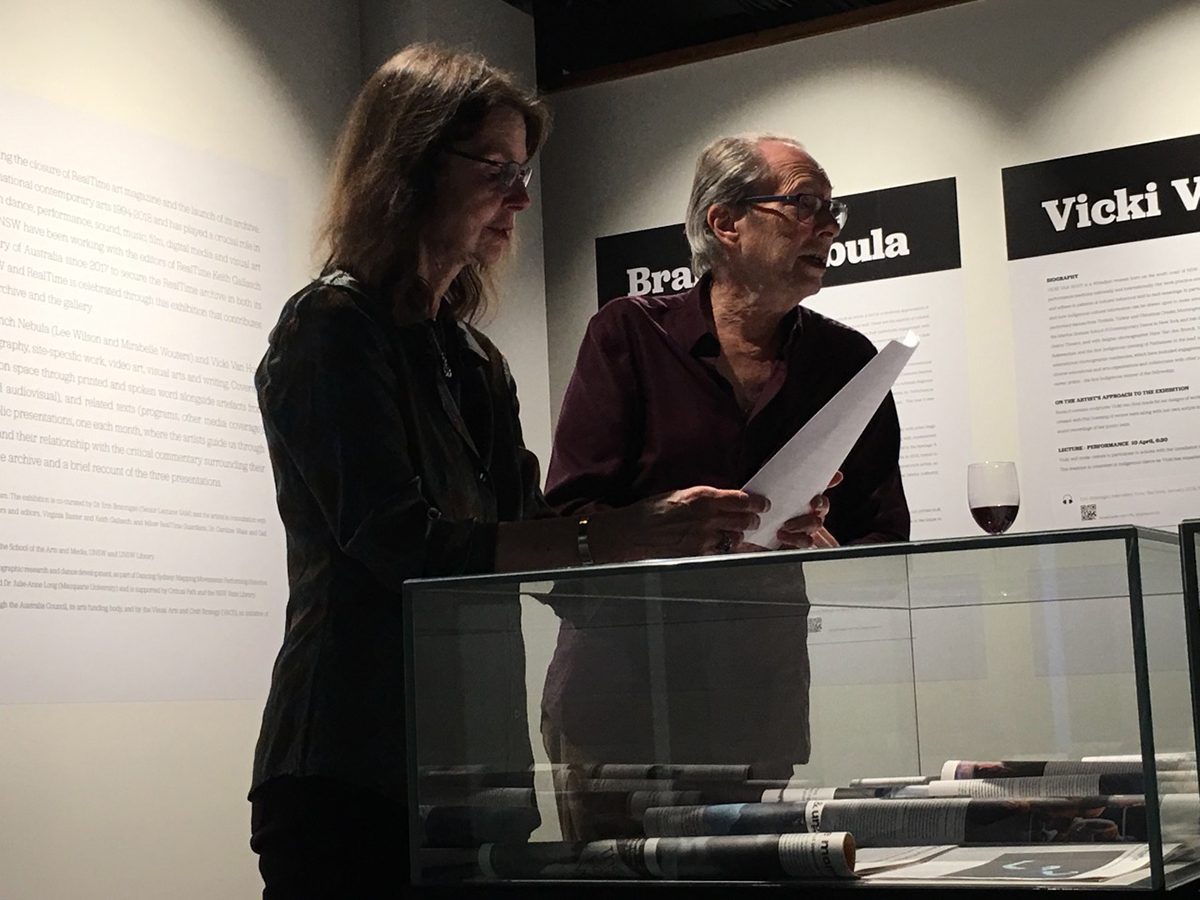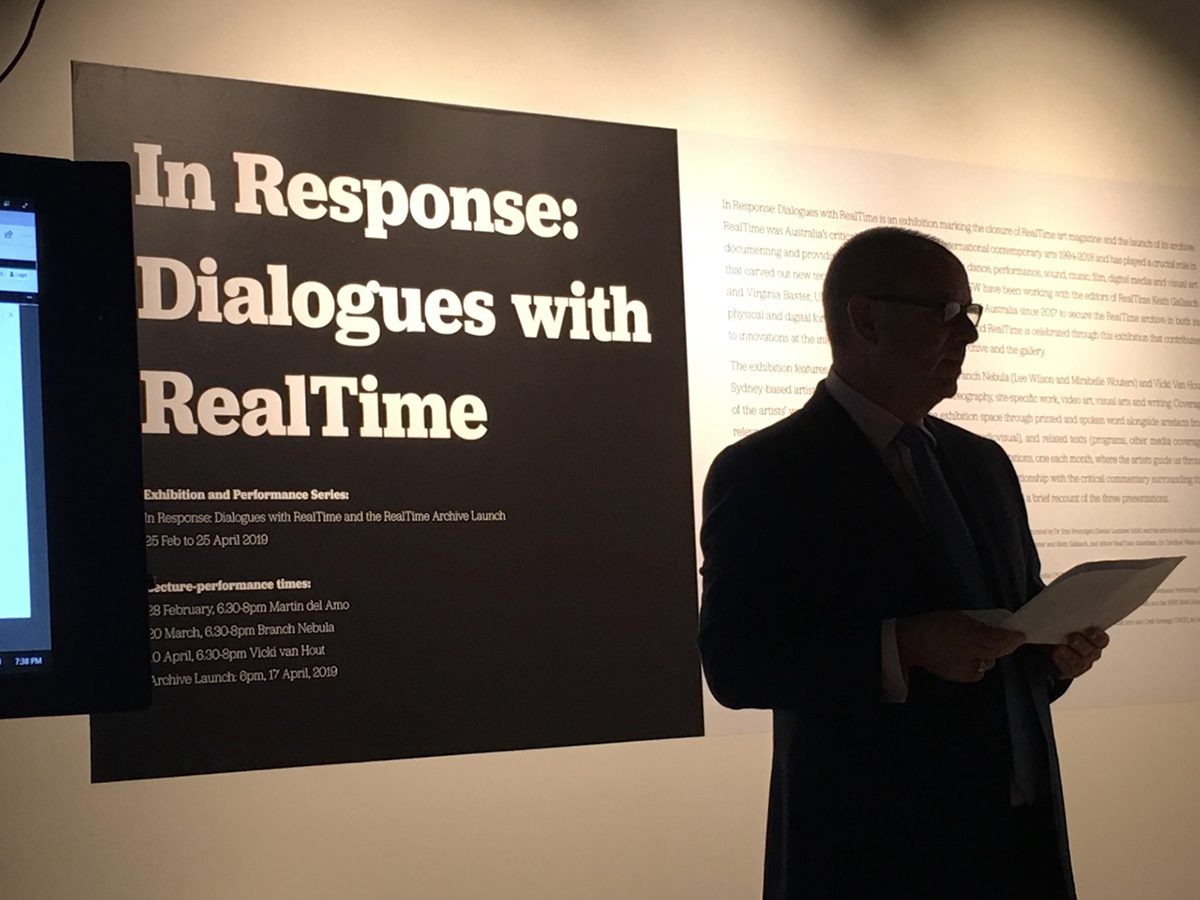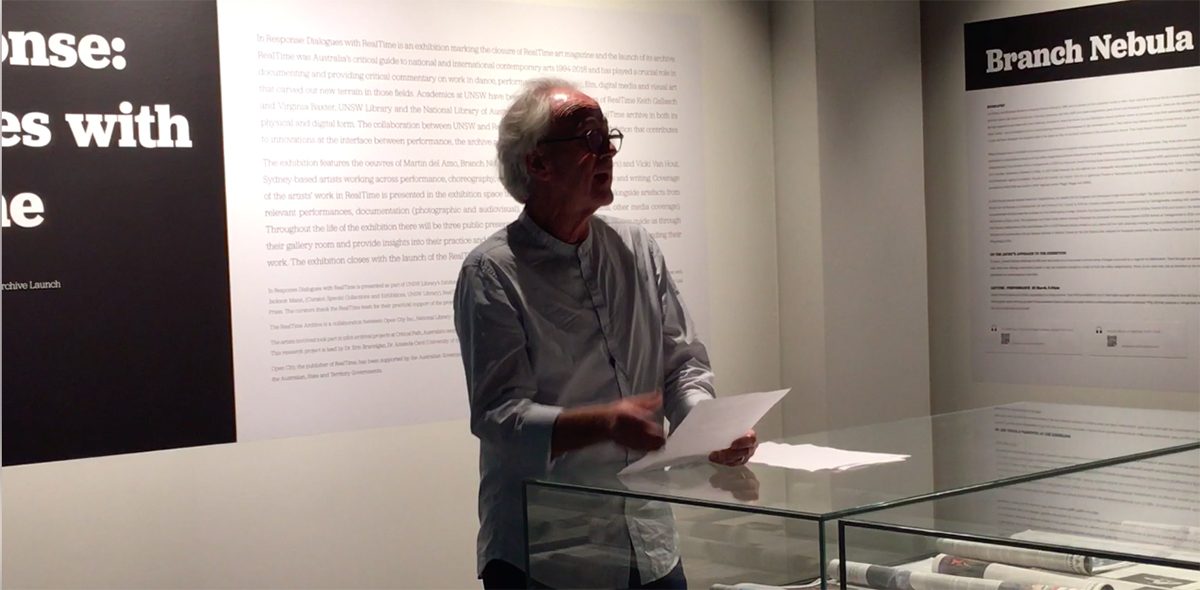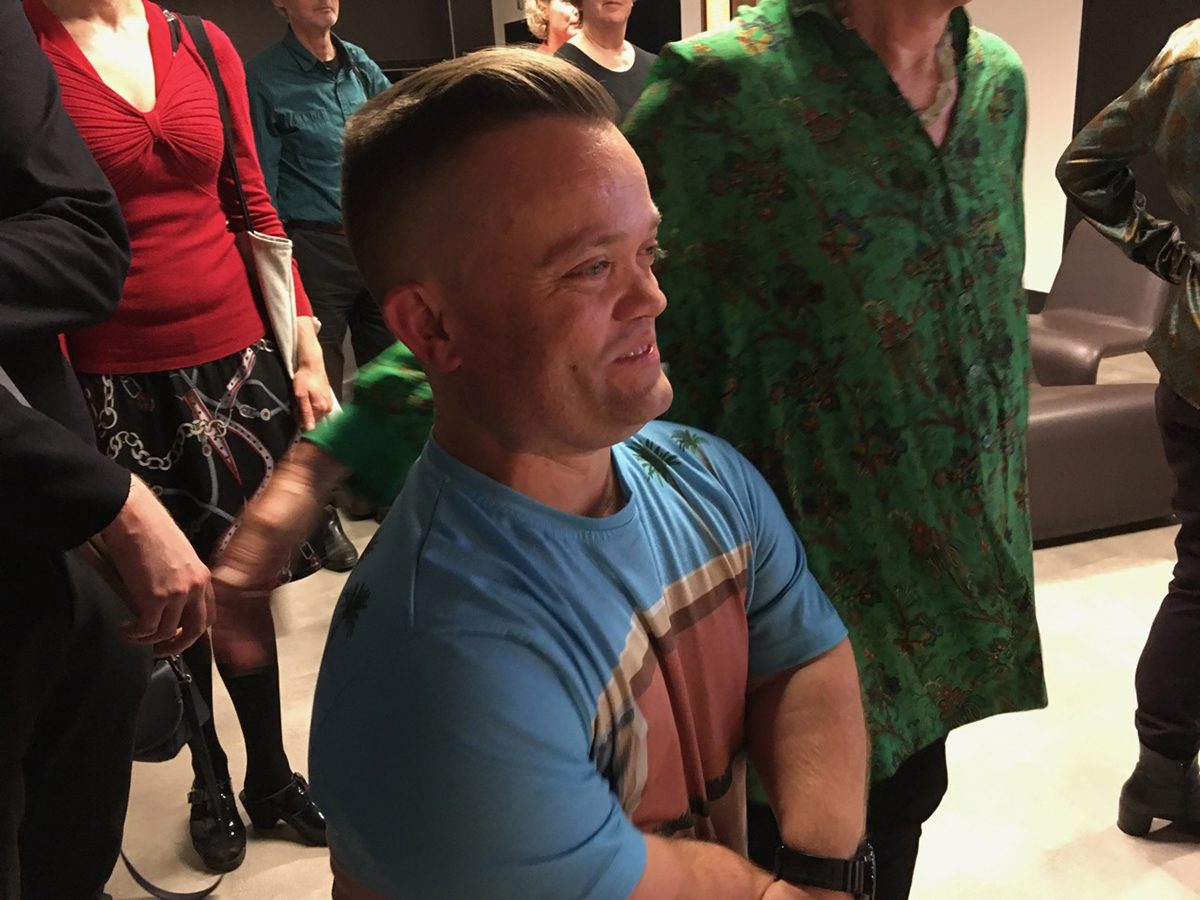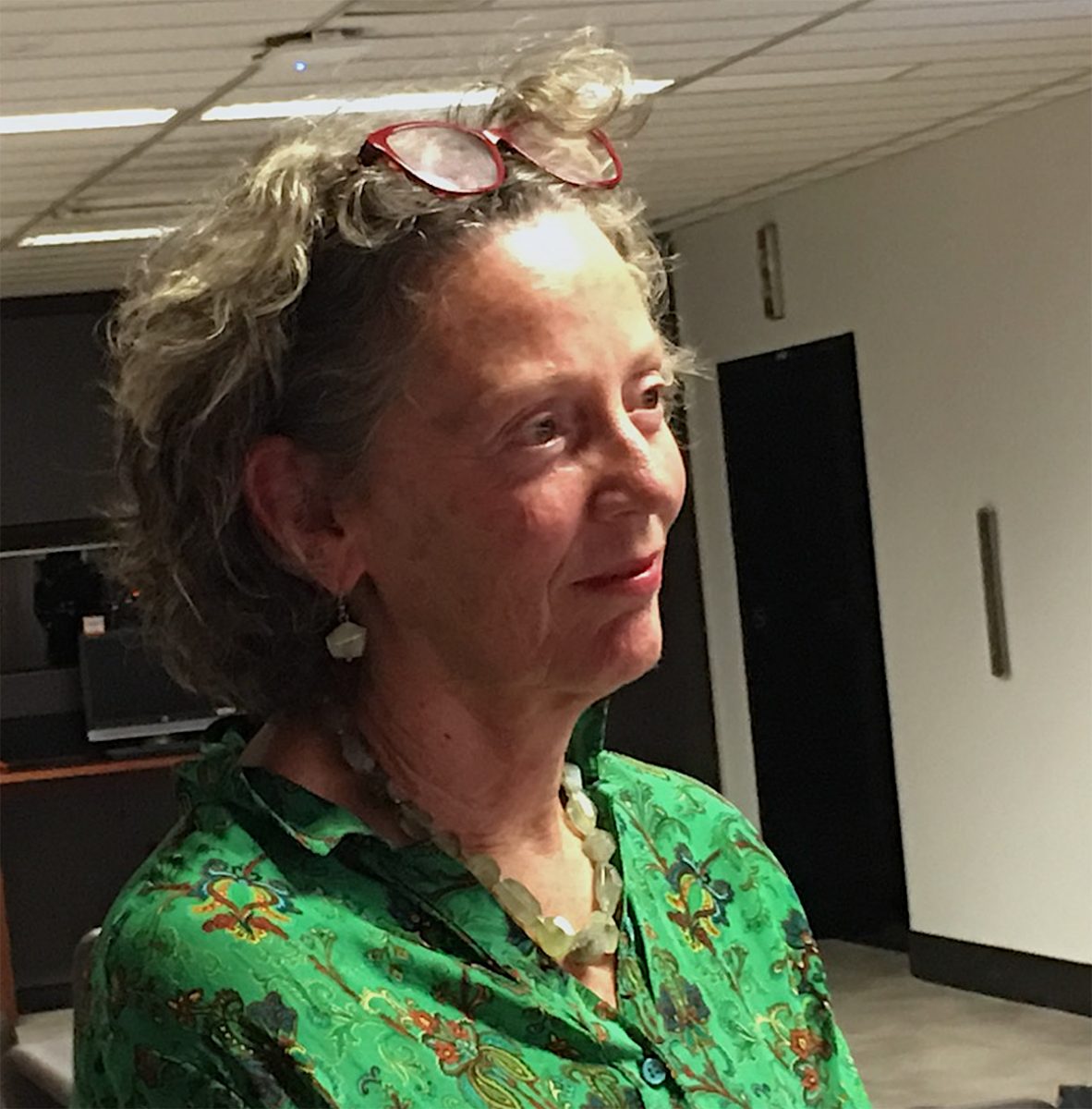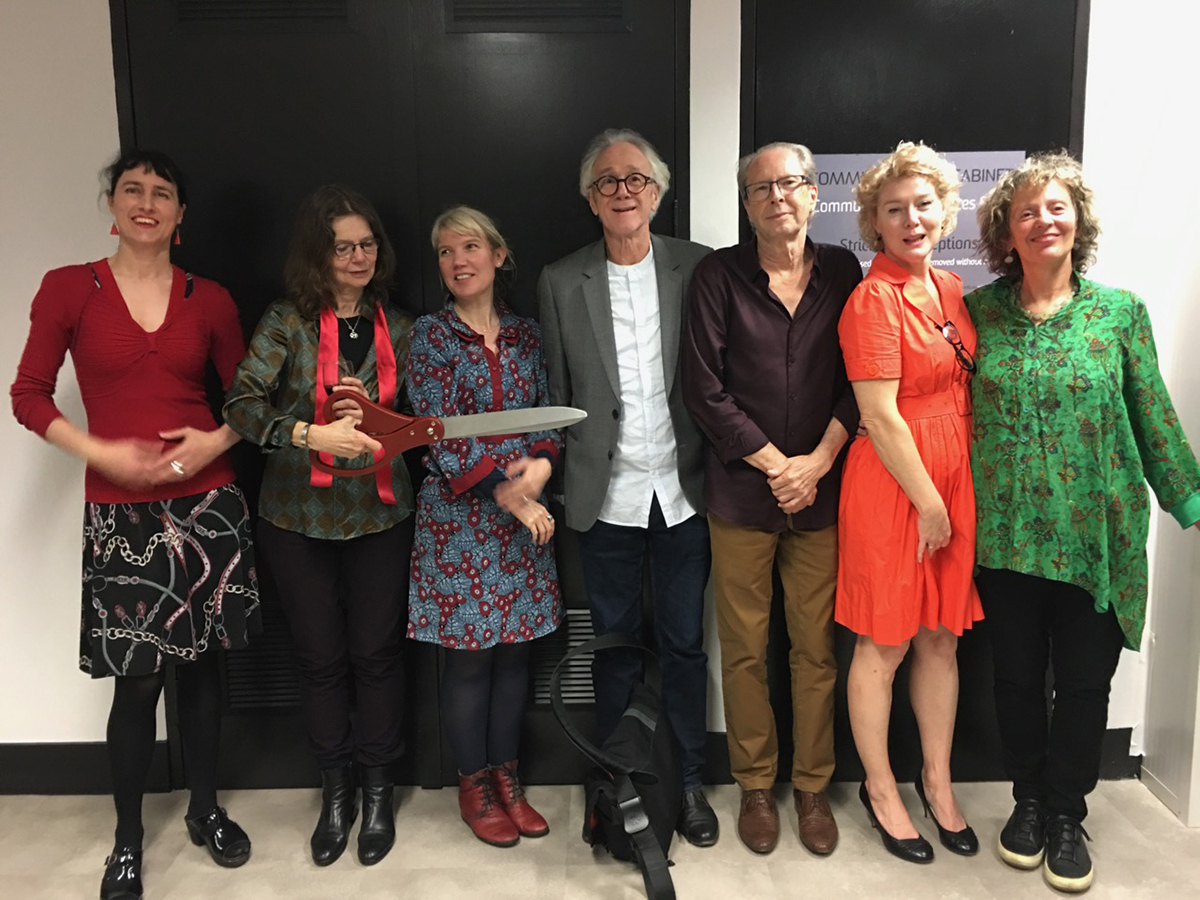
Archive alive: launching RealTime on TROVE
The launch of the 1994-2015 print editions of RealTime on the National Library of Australia’s TROVE website was a memorable night of performances, reminiscences and wise words about cultural memory and the importance of archiving, inflected with laughter and a few tears. It culminated with Professor Sarah Miller, wielding a giant pair of scissors, cutting a red ribbon—held at one end by ourselves and at the other by UNSW Librarian Martin Borchert—before a large monitor displaying RealTime on TROVE.
- Mirabelle Wouters (Branch Nebula), photo Sandy Edwards
- Vicki Van Hout, photo Sandy Edwards
- Martin del Amo, photo Sandy Edwards
In the first part of the evening, Martin del Amo spoke to the value of RealTime’s analytic reviews and Heidrun Lohr’s photographs of his work and danced an achingly exquisite solo embodying the passion of Maria Callas in performance. Vicki Van Hout, accompanied by Henrietta Baird, resurrected in words and movement a fragment of Vicki’s vibrant Briwyant. Vicki then reflected generously on the significance of RealTime reviews for her career and for Indigenous dance. Mirabelle Wouters of Branch Nebula continued the dialogue with curator Erin Brannigan initiated in the second of the four events that comprised a significant part of the exhibition In Response: Dialogues with RealTime, observing that for part of the company’s career the magazine had alone provided vital critical support.
Real time RealTime dialogue
We then presented our own response to RealTime, a dialogue addressing the magazine that we made, but which in turn made us—hitherto actors and writer-performers—editors, publishers and reviewers of often remarkable art, art that further transformed us personally, as we engaged for over two decades with works innovatively preoccupied with real time, bodies of all kinds, the senses and the interplay of actual and virtual, across artforms and across Australia and beyond in collaboration with a network of highly responsive skilled writers, many of them artists.
We quizzed each other about what we had experienced in those years of “tough but unalienated labour, doing our bit for cultural sustainability in the face of escalating neoliberalism” and revelling in “lingering over lush surfaces. Lost for words, aching to respond, to what just happened. Not jumping to conclusions; not rushing to judgement, entering the eternal loop. Embracing the work, taking it home, letting it in, like a lover, or Alien. Exercising the mirror neurons. Dancing the dance. Writing the dance. Keep talking to the work, talking to self. What happened to me this time? Is it still happening?” (You can read our Real Time Dialogue with RealTime in the attached PDF.)
Martin Borchert, Librarian, UNSW Library
The second half of the event comprised a series of incisive, entertaining speeches culminating in the launch of RealTime on TROVE and celebrating the RealTime website. Martin Borchert, Librarian, UNSW Library warmly thanked the National Library of Australia and Dr Hilary Berthon for partnering the digitisation of the magazine, UNSW Library staff members Robyn Drummond, Megan Saville, Jackson Mann and Maude Frances. He especially thanked Erin Brannigan and Caroline Wake of the UNSW School of Arts & Media and Keith and Virginia for their collaboration with UNSW Library on the digitisation venture.
Martin Borchert spoke of two kinds of ‘value adding’ the exhibition offered: firstly a kind of ‘glamour’ thanks to the performative and installation components which enhanced visitor engagement for the new exhibition space, and secondly the ways in which the audio (artist interviews) and video (performance documentation) components made for the exhibition would be preserved and further the range and depth of the RealTime archive.
In the first edition of RealTime in June 1994, Borchert noted, “the editorial announced that RealTime ‘opens up the possibilities for writers and artists everywhere in Australia to contribute to the spread of information and ideas across artforms and distance.’ I think this archive really achieves that and it’s a long time since the journal started so it’s nice to re-visit that mission.”
Tony MacGregor, Chair, Open City Inc
Tony MacGregor, Chair of Open City, the publisher of RealTime, spoke to the power of archives, incidentally complementing Martin Borchert’s vision of more diversified preservation, by citing Jacques Derrida’s Archive Fever (1995) in which the philosopher argued “that archives both shape and reflect the way we think, the way power is structured, the way we imagine ourselves, and that archives are changing, no longer vast libraries of documents recording the machinations of the powerful. They are becoming—must become—porous, heterogenous accumulations of multimedia. The archive can no longer be made of paper, but as we see around us is made up of all sorts of stuff. And, as the performances of Martin Del Amo, Branch Nebula and Vicki Van Hout over the past few months have eloquently demonstrated, the archive is often stored in the body, written in the flesh.”
Tony went on to thank the Australia Council and peer assessors of grant applications for their enduring support for RealTime, and UNSW Library and the NLA “for their commitment to nurturing the cultural history of Australia, not just in this instance, but in an ongoing and generous manner.” He reminded those gathered that it “was important to remember that Real Time was—is—an artists’ project,” “a collective enterprise.” “RealTime—and its editors and writers—have done more than serve a community, they have, in so many ways, made it. That is their gift to us (readers, writers, makers, audiences), and I thank them for it.”
Jeremy Smith, Australia Council for the Arts
Jeremy Smith, Director Community, Emerging & Experimental Arts, Australia Council for the Arts, recalled his first encounters with RealTime, picking up a copy in 1995 at Perth’s PICA, where Sarah Miller was Director. Later, as a young lighting designer, he received a positive mention in a RealTime review: “that’s what set Real Time apart—its editors, writers and contributors saw and considered elements others didn’t. It was as if they were always searching for new ground and looking beyond the horizon—the as yet unseen. They saw and wrote about the new aesthetics and hybrid forms, the delights for us audiences long before others, helped promote and increase our enjoyment, cultural literacy, plus stimulated collaborations and conversations.”
Jeremy reflected on the “robust relationship” between the Australia Council and RealTime, citing “the crucial role Real Time—especially Keith—has played as a critical friend of the Australia Council…highlighting in the magazine the Council’s ‘mistaken’ arts practice restructure in 2004 and 2005” (the passionately resisted dismantling of the New Media Arts Board). He amusingly recalled Keith’s deployment, in the Sydney Morning Herald, of an ecological model of the arts, with the Council as a threatening monocultural omnivore and innovative artists as humble slime mold—networking and shapeshifting. Jeremy observed, “underpinning that funding partnership since 1994 has been the endorsement and praise of countless numbers of peers from around the country who have validated the continued support of this crucial part of our ecosystem. That alone speaks volumes.”
Jeremy also acknowledged the presence at this launch of Andrew Donovan, Director, Artist Services at Australia Council for the Arts, “a significant contributor to the RealTime-Australia Council relationship and indeed the contemporary and experimental arts sector over many, many years.” Andy was indeed very welcome.
While lamenting the current absence of a national across-the-arts magazine, Jeremy noted “seeing pockets of the contemporary and experimental arts sectors—organisations and independent artists—responding in small, unique, considered and important ways to fill this void. I genuinely hope this continues.
“It’s never an easy decision to call time, and to windup. It takes bravery. I commend Keith, Virginia, the Open City Board and all of the contributors to Real Time for 25 years of bravery, courage, fierce articulation, wisdom—and change.”
Professor Sarah Miller AM
Professor Sarah Miller recalled reviewing Open City’s Photoplay in 1988 for Art Almanac and meeting us when, in the period of her directorship of Performance Space 1989-93, “Open City was one of the key ensembles working out of Performance Space. Ostensibly casual and chatty, but meticulously crafted, their work was distinguished by their collaborations with artists from a range of artform backgrounds, specialists from other disciplines and industries, and dealing with the politics of the everyday. Does this sound familiar?”
Sarah described the considerable challenges for artists in the 1980s and 90s in “refusing to conform to a bunch of fairly prescriptive ideas about what constituted real art, real theatre, real music, or real dance…” She recalled the Australia Council’s subsequent “establishment [in 1993] of the Hybrid Arts Committee—later the New Media Arts Board, now the Emerging and Experimental Arts Fund—which provided dedicated funding to artists whose work sat outside conventional parameters” (though not mentioning her own role as passionate advocate on Australia Council boards). Sarah then detailed outcomes of the RealTime vision: experiential writing, inclusiveness, free national access in print from 1994 and online from 1996, national and international perspectives for artists and readers, aided by review-writing workshops around the world.
Unable to resist the pun, Sarah described the NLA’s archive as a Treasure TROVE and thanked UNSW Library and the National Library of Australia for “making the TROVE RealTime archive an invaluable resource for Australian artists’ sense of their own and their collective histories, for inspiring students and emerging artists, for providing rich material for researchers and arts historians, as well as anybody curious about what happened.”
Before cutting the ribbon to launch RealTime on TROVE and our upgraded website, Sarah concluded her speech saying, “I really miss RealTime. It has been an essential part of my life for 25 years, and I know that’s true for everyone here tonight. There really aren’t the words—which is why I’ve used so many—to thank Keith and Virginia for their commitment, passion, rigour, tenacity and hard work, and above all for putting artists and their work front and centre. Absolutely mammoth achievement.”
Thanks
Sarah dextrously scissored the red ribbon, completing the launch, save for rapidly listed thanks from us to everyone who had performed or spoken on the night, to the NLA (and Dr Hilary Berthon) and UNSW Library (and Megan Saville), to RealTime website designers Graeme Smith and The Mighty Wonton, Open City Board members Tony MacGregor, John Davis, Julie Robb, Urszula Dawkins and Phillipa McGuiness, Assistant Editor Katerina Sakkas and Online Producer Lucy Parakhina, previous staff members (Gail Priest above all), to Erin Brannigan for In Response: Dialogues with RealTime and much else, Caroline Wake and, for creatively dialoguing with RealTime, special thanks to Martin Del Amo, Branch Nebula (Mirabelle Wouters and Lee Wilson) and Vicki Van Hout.
To all those who have contributed to RealTime over these many years—writers, artists, readers, supporters, advertisers and funders from across Australia and beyond—thanks for being part of the epic making of an intensely memorable, very much alive archive.
You can read the complete speeches and our Real time dialogue with RealTime here.
–
In Response: Dialogues with RealTime, Archive Launch, UNSW Library Exhibition Space, UNSW, Sydney, 17 April, 2019
Top image credit: L-R: Katerina Sakkas, Virginia Baxter, Gail Priest, Tony MacGregor, Keith Gallasch, Erin Brannigan, Sarah Miller, photo Sandy Edwards


